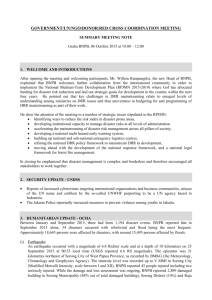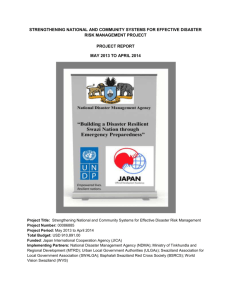Title of the success story/case study Building Resilient Communities
advertisement
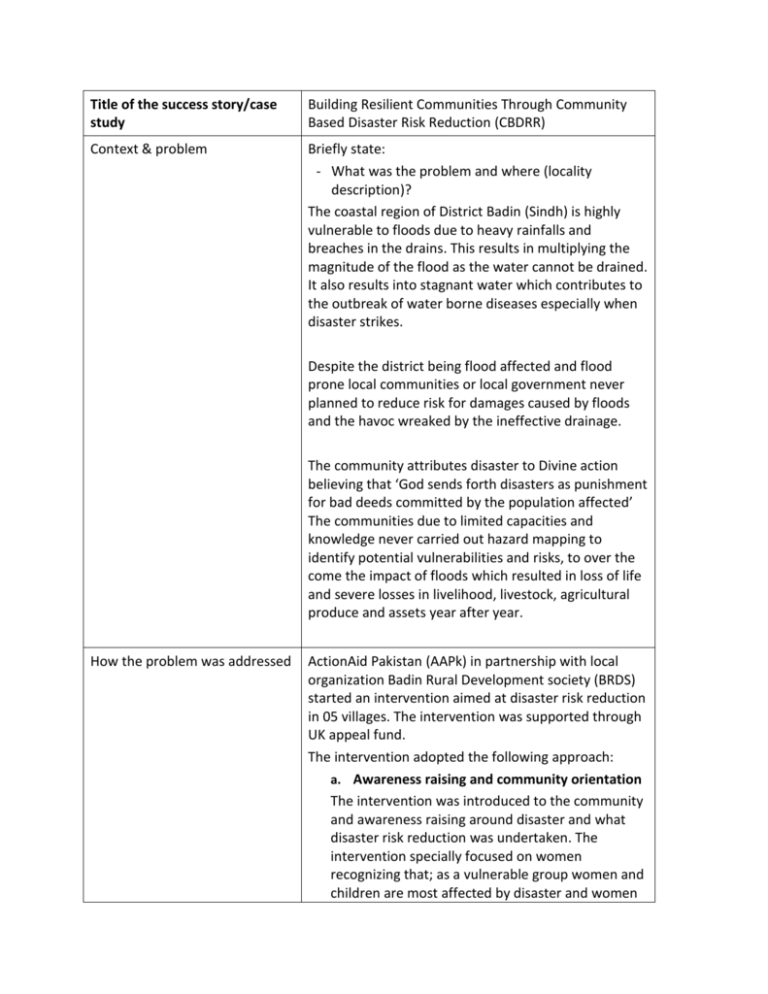
Title of the success story/case study Building Resilient Communities Through Community Based Disaster Risk Reduction (CBDRR) Context & problem Briefly state: - What was the problem and where (locality description)? The coastal region of District Badin (Sindh) is highly vulnerable to floods due to heavy rainfalls and breaches in the drains. This results in multiplying the magnitude of the flood as the water cannot be drained. It also results into stagnant water which contributes to the outbreak of water borne diseases especially when disaster strikes. Despite the district being flood affected and flood prone local communities or local government never planned to reduce risk for damages caused by floods and the havoc wreaked by the ineffective drainage. The community attributes disaster to Divine action believing that ‘God sends forth disasters as punishment for bad deeds committed by the population affected’ The communities due to limited capacities and knowledge never carried out hazard mapping to identify potential vulnerabilities and risks, to over the come the impact of floods which resulted in loss of life and severe losses in livelihood, livestock, agricultural produce and assets year after year. How the problem was addressed ActionAid Pakistan (AAPk) in partnership with local organization Badin Rural Development society (BRDS) started an intervention aimed at disaster risk reduction in 05 villages. The intervention was supported through UK appeal fund. The intervention adopted the following approach: a. Awareness raising and community orientation The intervention was introduced to the community and awareness raising around disaster and what disaster risk reduction was undertaken. The intervention specially focused on women recognizing that; as a vulnerable group women and children are most affected by disaster and women are often the first responders in emergency situations. Awareness raising activities were specifically targeted at women too; along with men. b. Mobilization: Communities were explained the importance of disaster risk reduction and the benefits planning and mitigating risks can bring. The whole ‘a stitch in time saves nine’ metaphor was elaborately explained to the community and women groups to create ownership of the intervention. c. Organization: Women among other community members were organized i.e. explained how they could work together and support each other in identifying community resources and contribute to risk reduction. Groups were formed – women groups were also formed so that womens’ needs can be voiced and the risk reduction is gender sensitive. d. Hazard mapping: The groups formed (with support of BRDS and AAPk) worked together for contingency planning of each settlement. The plans identified local resources, potential threats and hazards, vulnerabilities and capacities. e. Plan development: Plans were developed through a participatory approach. This plan identified areas of intervention; behavioral change within the community and actions and linkages development with government institutions. f. Lobbying and Advocacy: The local communities drafted a letter highlighting the key risks needing mitigation and sent it to DDMA , PDMA, NDMA, President and Prime Minister’s office. g. Under the project a set of contingency stock has been delivered to community, which includes wheel barrows, spade, picks shovels and rescue ropes. The community has been sensitized for reducing risk and vulnerabilities in case of disaster. Now women and men are both working together for raising the level of platforms in front of their homes. These raised platforms will help communities to save livestock and other assets during the floods. The key areas in which women were specifically addressed were: Household level planning to address risk reduction – as households are a woman’s fortress and they are the key force which can take and maintain measures at home-level. Women were given first aid training so that the community can receive first aid immediately if need arises. Women learnt to take part in rescue operations, controlling bleeding , CPR for infants, children and adults ) Protection management committees were also formed at village level (these have 5 women members) as part of implementing the risk reduction plan to ensure that women and girls can be ‘protected’ in case disaster strikes and harassment, abductions and any other type of assault can be kept at bay by creating vigilance mechanism at community level. Women were represented in camp management committee (5 women in committee) so that camp management can be gender sensitive and women’s needs are addressed. Relevance to HFA 1 This case study falls under priority area 1 and 2. Priority area 1 and its key activities (ii-e) firstly we assess the existing human resource capacities for DRR at community level and develop capacity building plans and programmes for them. As far as the community participation (iii –h), we promote community participation at all level specially focus on women participation in DRR through different activities. HFA priority area 2, we formed groups (male and female) and work together for contingency planning. We developed and widely disseminated risk maps and related information to decision makers at all level. Challenges Results The DRR project design was not child focused interventions / or school based interventions, though children are also vulnerable during disasters and there is dire need for addressing ‘protection’ concerns in regard to children too. It is challenging to stick to donors mandates and scope in time of emergency relief and work on disasters. District Disaster Management Authority has capacity issues in terms of human resource , equipment and even linkages for influencing other public institutions to ensure adaptation of infrastructure (eg schools, roads, homes etc) to be flood resilient. The hazards maps identified major risk mitigation measures to be taken for the community’s resilience to be built against disaster – such mitigation and investment is the State’s responsibility but the State neither owns nor addresses the issue. The DDMA lacks resources to take on such measures. Time required for proposal writing and making proposals ‘look good’ on paper wastes considerable time where needs of community could be addressed. Proposal formats should be very simple when in comes to relief and even initial rehab efforts. Due to bureaucratic structure and capacity issues at local govt level – community owned DRR is difficult to link/add to the State’s contingency plans. - Village level disaster management committees formed in 05 village, each committee has 10 members (05 women and 05) , this committee is responsible for implementation of community based risk reduction actions and lead to advocacy initiatives. These committees comprise of women members too which is a stepping stone for women empowerment in the area - There are more than 30 households with raised platforms and women are more actively involved in finishing work of these platforms – which shows community ownership (in men as they are letting women engage into these activities and in women as they are actively participating understanding that it is their need). There are two women committees (protection committee and camp management) which were formed in each settlement, each committee is composed of 05 women, and these women are trained in first aid skills and sensitized on protection needs of women and children. Conclusion Contact information in case we need more details The community based initiatives are quite effective and owned by the community, because these are proposed and implemented by the communities themselves. There is thus strong ownership among the community, which makes themeasy to maintain and replicate within the village or in other villages . Village level disaster management committees have linkages development with DDMA and government authorities Contingency plans prepared and advocacy undertaken with government agencies Training of emergency response teams ERTs to management rescue and first aid at community level Demonstrating better and safer housing models and training of local artisans to construct resilient and safer structures Development of village safety plans and ongoing advocacy with local government for incorporation of community DRR needs in State agenda. Linkage development with DDMA , PDMA and NDMA as per disaster related institutional framework of NDMA Yusra Qadir yusra.qadir@actionaid.org Programme Funding Coordinator Action Aid Pakistan Khadim hussain 92-331-2689045 khadimbrds@yahoo.com







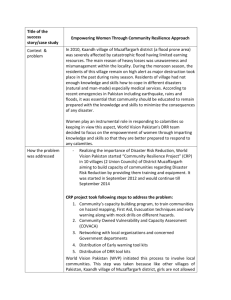
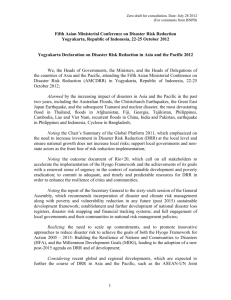
![Terms of reference [DOCX 143.32 KB]](http://s3.studylib.net/store/data/006681779_1-ad60c361da20f7741e6c7b47cfa08e81-300x300.png)
